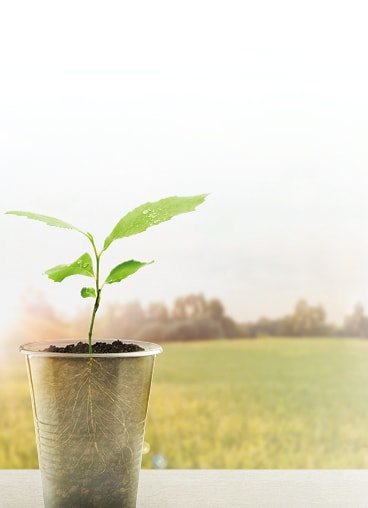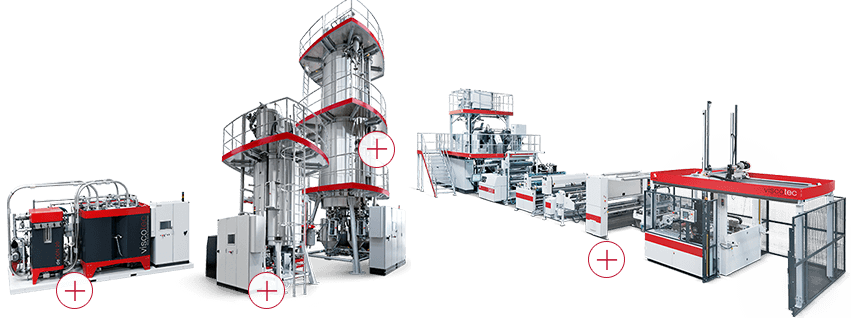When a few years ago some NGOs began campaigning with a massive social media awareness program highlighting ocean plastics and plastics in general, the mood in the industry sank with the increasing aggressiveness of these campaigns. Promptly, some marketing experts searched for an immediate solution to encounter the „packaging problem“ and quickly promoted alternative materials in a very media-effective way.
Now, a few years later, more and more serious studies show that, holistically considered, there is no real alternative to plastics as a packaging material and that plastics has almost every time a better performance regarding CO2, water & other footprints compared to all other packaging concepts, as long as the packaging is recycled in a way to be able to produce the same packaging again.
The PET bottle is green
With the PET bottle we have implemented this principle like no other product worldwide. Why? Because stakeholders have taken care that
- PET is not contaminated with additives.
- during the production of virgin PET, there are no different processes for food and non-food PET.
- brand owners have specifically targeted the disappearance of PVC labels.
- due to the work of some pioneers, there is a clear legislation and also rules from the FDA for recycling
and, of course, because
- PET, due to its unique migration and barrier properties, is the best material and, from the food safety point of view, the only suitable plastic for food-grade recycling.
- the viscosity of PET can be changed as desired using simple thermal processes, and thus the applications are almost unlimited.
Serious comparisons of beverage packaging regarding CO2 emission have proven that PET disposable bottles perform better in the bottle-to-bottle cycle than glass returnable bottles.
But that is also the end of PET‘s success story from the recycling point of view. Besides bottles, the post-consumer recycling rates in the PET market are very modest at best. Only bottles hold the recycling rates at a high level. But why is it like that? Are these economic or technical reasons?
PET thermoforms are also green - basically
Unfortunately, beside bottles, we are facing fundamental recycling issues. Not with down-cycling, but when it comes to recycling according to the cradle-to-cradle principle. PCR recycling rates of PET thermoforms are close to 0%. This means 1 million tons of lost material in the EU and another one million tons in North America, which are either burned or dumped in landfills.
The main problems are:
- in the FFS field the PET/PE lamination, which accounts for 50% of the market
- in the cup segment, as PET is not
- suitable for hot-fill and therefore PS
- is used instead of PP
- pharmaceutical packaging made
- of PVC (sorting and separation)
- labeling
- colors
viscotec makes thermoforms green - and great again
Following the development of our SSP reactors, PET sheet lines, etc., viscotec has been working intensively for the past two years in the field of PET tray recycling and product development of PET trays, cups, and FFS packaging deserving the claim „designed for recycling“ for the past two years.
Why PET, why not PS or PP?
PET is currently the only solution for closed loop recycling that we need in order to reduce CO2 emissions. Due to the barrier properties of PET, a multilayer structure of packaging is not necessary and EVOH barrier layers also have no advantages. Because of PET’s migration values of a similar decontamination or migration of substances from a recycled packaging into the food is simply impossible. We at viscotec see PET as the only option for food grade recycled plastic packaging with the current stringent food safety criteria in place. Therefore, all food packaging should consist of PET and all non-food packaging of PP or HDPE. Besides that a strict ban on PS and PVC packaging should be implemented.
But PP and HDPE are lighter than PET – hence they have a low CO2 footprint
In the first superficial view this may be true, but not if you include the recycling cycles for your product. Here, PET is far superior to polyolefins.
We have the technologies, why not use them?
In order to operate meaningful recycling of thermoforms, a few points must be fulfilled:
- The legislative aspect, especially in Europe. After more than 10 years since regulation 282 came into force, the European Commission has still not managed to put EFSA opinions into action. This malady must be remedied immediately.
- 50% of the thermo- and vacuumforms in the EU consist of PET/PE laminate. There have long been alternatives for PE lamination, but some market participants are, due to short-term economic considerations, somewhat resistant to recycling. EVOH barrier layers are not useful for PET and therefore unnecessary.
- For an easier separation of thermoform material streams, PS and PVC pharmaceutical packaging has to disappear from the market.
- A clear definition of high quality recycling and financial incentives for a packaging design which is suitable for high-quality recycling. High-quality recycling means that 100% of the same packaging can be made from a packaging after recycling (transparent food packaging to transparent food packaging).
With a promise to continue our research at viscotec for a better environment and with our customers we will increase our installed recycling capapacity worldwide from 1.5 mio. to 2.0 mio. tons within the next 2 years.
Markus Fellinger, viscotec





